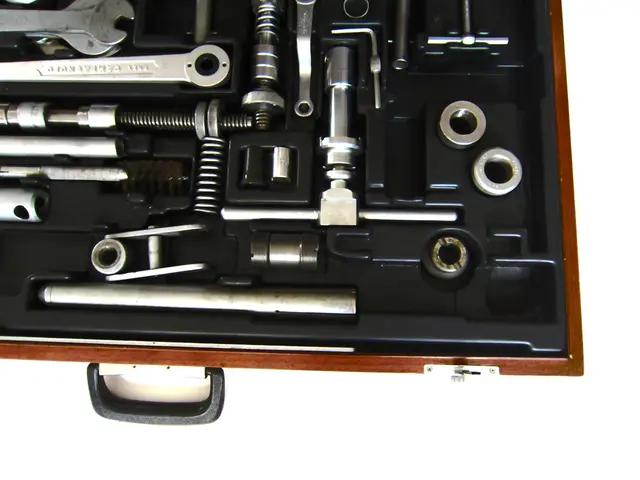five straightforward methods for painting trims:
Pimp Your Pad: A Guide to Refreshing Your Trim in 8 Steps
Gather Your Supplies
Tools and Equipment
- Small, angled paintbrush
- Putty knife (for carpeted floors)
- Sponge
- Sandpaper (80, 100, and 120 grit)
Materials
- Paint
- Primer
- Paint tray
- Painter's tape
- Drop cloths
- Spackling compound
- Caulk (for gaps, if needed)
- Safety goggles
- Dust mask
Let's Get This Trim Poppin'!
Step 1: Protect Your Space
Don't let paint accidents ruin your floors, walls, and furniture. To prevent chaos, move your furniture and rugs away from trim, lay painter's tape along the wall and floor where it meets the trim (use a putty knife for carpeted floors), and place drop cloths to protect the floors.
Step 2: Clean and Prep the Trim
Start by giving your trim a good scrub with a damp sponge to remove any dirt or grime. For especially dirty baseboards, use soapy water and a sponge to really clean it up. After cleaning, sand the trim using appropriate sandpaper, starting with rougher sandpaper for older, worn trim and finishing with smoother sandpaper for new, smooth trim. Don't forget to wear safety equipment to protect your eyes and lungs!
Step 3: Fix Those Flaws
As you're sanding, take note of any cracks, holes, or dents. Fill those bad boys with spackling compound, let them dry, and sand them smooth using 120-grit sandpaper. If needed, use caulk to fill any gaps between the trim and walls.
Step 4: Prime Time
First, prime any filled-in areas to ensure they blend with the rest of the trim after painting. Let the primer dry and sand it lightly. Then, prime the entire trim and let it dry. Repeat the priming, drying, and sanding steps if needed.
Step 5: Choose Your Paint
Select a high-quality trim paint in a satin or semi-gloss finish for added durability.
Step 6: Get Painting
Using an angled brush and working in sections (2-3 feet), paint the trim in long, smooth strokes following the wood grain to minimize brush marks. Once you've painted a section, go over it with one long stroke. Repeat this process, section by section, until all the trim is painted.
Step 7: Wait and Clean
Allow the paint to dry completely (4-6+ hours; check the label) and then take a well-deserved break. Clean your brushes immediately with warm, soapy water (for latex paint) or an appropriate solvent (for oil-based paint).
Step 8: Apply a Second Coat (if needed)
If the first coat isn't covering adequately, go ahead and apply a second coat using the same techniques.
And that's it! Your trim should now look as fresh as a daisy and nicely complement the rest of your home. Happy DIY-ing, you crafty cat!
Additional Insights:
To ensure a professional finish when painting trim, follow these pointers:
Clean the trim thoroughly before sanding.Use a low-grit for old, worn trim and a high-grit for new, smooth trim.Fill cracks, holes, and gaps using spackling compound and caulk.Prime repaired areas and the entire trim to ensure even coverage.Choose a high-quality, glossy paint for long-lasting results.Work in sections to maintain a smooth finish.Wait for the paint to dry completely before placing furniture back in place.
Sources:- HomeAdvisor: https://www.homeadvisor.com/r/how-to-paint-baseboards/- Bob Vila: https://www.bobvila.com/articles/painting-baseboard-molding/- The Spruce: https://www.thespruce.com/how-to-paint-baseboards-3211949
- A home improvement project to enhance your home's trim is within your reach with a simple guide: Pimp Your Pad: A Guide to Refreshing Your Trim in 8 Steps.
- To prevent paint accidents and ensure a clean home-and-garden lifestyle, move furniture and protect the floors, walls, and furniture with drop cloths and painter's tape before starting.
- For best results, don't forget to follow the steps, such as cleaning, prepping, filling flaws, priming, choosing paint, and painting the trim with an angled brush following the wood grain.
- Using high-quality satin or semi-gloss paint and quality tools like a small, angled paintbrush, you'll achieve a professional finish that boosts your home improvement and home-improvement skills.
- By following this guide's steps, you'll transform your home with a fresh, polished look that realsimple DIYers can proudly enjoy, making it a 4c53dcb2eb624663c28c2a4323e4bd7e part of your lifestyle.
- After painting, give your tools a proper clean and wait for the paint to dry before placing furniture back in the increasingly improved home.








